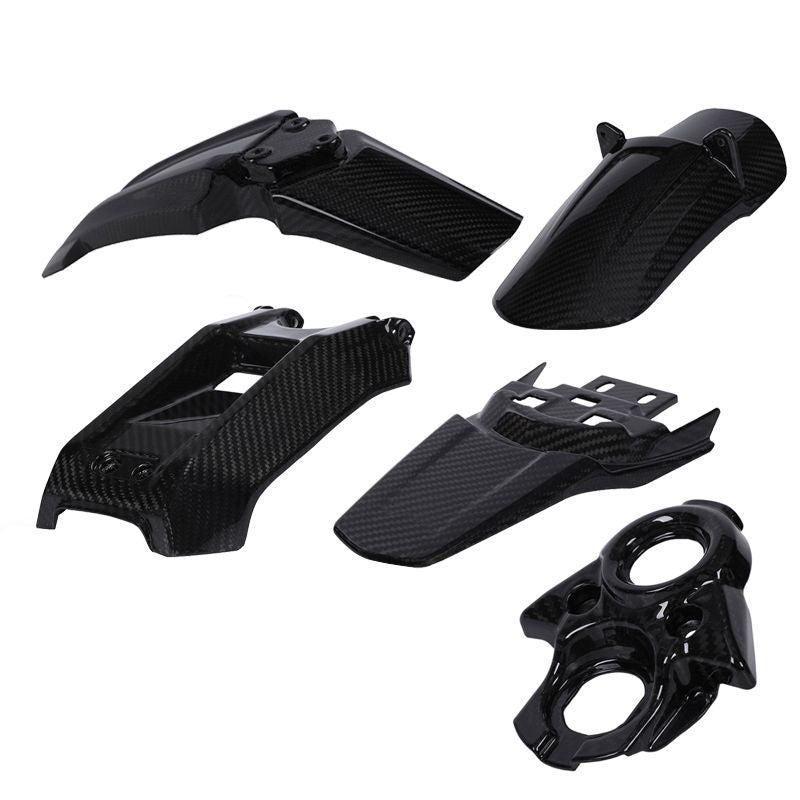Materials and functions of TK02 full face helmet
Thank you for your recognition of NOBLEMAN. NOBLEMAN promises that all products under the NOBLEMAN brand will be sold by domestic brands for more than half a year without quality problems. After optimizing details and improving quality, they will be included in the brand and sold globally. In this blog we would like to talk about the materials we use and their functions. Also, we will go into details of some materials just to give you more background knowledge related tp the specific material.
TKO2 helmet (visors, shell, buffer layer, inner lining, face guard, and strap)
Double eye visor design and material aids to protect eyes and face.
The inner and outer visors are made of polycarbonate, and the inner goggles are equipped with "anti-fog" and "anti-ultraviolet" functions, which are suitable for daytime use. The outer goggles cover a large area of pure transparent polycarbonate, suitable for rides at night.
(Polycarbonate: Has good impact resistance, thermal distortion resistance, good weather resistance, high hardness, and UV radiation resistance. The following is the physical strength test result of polycarbonate.)
Helmet shell: Impact resistance and puncture resistance
The shell adopts an integrated injection molding design to maximize the uniformity of the overall force, thereby greatly increasing the impact resistance. All materials are ABS modified formula.
ABS plastic is a terpolymer of three monomers of acrylonitrile (A), butadiene (B) and styrene (S). The relative content of the three monomers can be changed arbitrarily and made into various resins. There are three common properties of the components, A makes it resistant to chemical corrosion, heat resistance, and has a certain surface hardness, B makes it have high elasticity and toughness, and S makes it have the processing and molding characteristics of thermoplastics and improve electrical properties. Therefore, ABS plastic is a "tough, hard, and rigid" material with good comprehensive performance, and the strength of modified ABS has been greatly improved.
The test items are as follows for the materials:
Mechanical properties: density, hardness, surface resistivity, dielectric properties, tensile properties, impact properties, tearing properties, compression properties, adhesive strength, wear resistance, low temperature properties, resilience properties;
Aging performance: heat aging, ozone aging, ultraviolet lamp aging, salt spray aging, xenon lamp aging, carbon arc lamp aging, halogen lamp aging;
Liquid resistance: lubricating oil, gasoline, engine oil, acid, alkali, organic solvent, water;
Combustion performance: vertical combustion, alcohol burner combustion, roadway propane combustion, smoke density, burning rate, effective combustion heat value, total smoke emission;
Applicable performance: hydraulic pressure resistance, impulse test, electrical conductivity, water tightness, air tightness;
Production parameters: melt index, viscosity, mold shrinkage, melting temperature, etc.
Buffer layer: Absorbs impact's energy
Using the combination of the fusion MIPS system and high-density EPS, the helmet’s greatest effect is not impact resistance, but energy absorption. At the moment of high-speed impact, the impact energy can be quickly absorbed and evenly distributed to the buffer layer of the entire helmet, thereby maximizing Protect the head and reduce injuries. The TK02 buffer layer design will instantly activate the MIPS system when the impact force exceeds the energy absorption range of the helmet, and the EPS will be disconnected from the helmet link, allowing the head and PES to move in a small area inside the helmet to avoid the cervical spine injury.
Inner lining: Fixes head comfortably
The inner layer is made of high-fiber tear-resistant fabric, and the top is designed with a hanging design and a wrap-around design. The biggest purpose of this design is also with safety as the primary goal. When the impact surface is on the top of the head, there is an outer shell, a buffer layer, and an inner The suspended design of the layer prevents the top of the head from directly contacting the helmet body, and the impact energy cannot be directly delivered to the impact surface of the head; the main purpose of the thickened wrap-around design is that when the surrounding is impacted, the helmet will not side slip at the moment of impact. Loss of protection effect (wear a helmet as best as possible to have a certain sense of tightness, as the use time increases and light impact, the cushion layer of the helmet will shrink, so that the internal space of the helmet will become larger, and the normal helmet life will be the longest. For 5 years) so that the user can have sufficient fit and energy absorption effect when wearing it.
Face guard: Protects lips and jaw
The main material of the forehead protection part is modified ABS and the cushioning layer is soft polyurethane, so that when the user's jaw is hit, it will not be able to withstand the limit in an instant and cannot rebound like ordinary energy-absorbing materials, while the polyurethane has super high rebound. Elasticity and shock absorption, to maximize the protection of users.
The installation of airbags in automobiles is a requirement for the development of the modern automobile industry and plays a major role in protecting the lives of drivers. This kind of airbag must have a certain strength to withstand high-speed impact, and it must have good low-temperature flexibility. It is suitable to be made of polyurethane. Each airbag uses about 300 grams of glue. It can be manufactured by using the high strength and high load-bearing capacity of polyurethane elastomer. The load-carrying capacity of tires for medium and low-speed heavy-duty vehicles is 7 times that of tires of the same specification made of natural rubber.
Strap: To fix the helmet on the head
The material of the strap is modified polyester fiber, which is a synthetic fiber obtained by spinning polyester formed by polycondensation of organic dibasic acid and diol, referred to as PET fiber. Compared with natural fiber, polyester has a low moisture content and is breathable. Poor performance, poor dyeability, easy to pilling and fuzzing, easy to stain and other shortcomings. In order to improve these shortcomings, chemical modification and physical deformation methods are adopted. The advantages of modified polyester fiber are as follows:
①High strength: the dry state strength is 4~7cN/dex, and the wet state decreases.
②Moderate extension: 20%~50%.
③High modulus: Among the large varieties of synthetic fibers, polyester has the highest initial modulus, which can be as high as 14~17GPa, which makes polyester fabrics stable in size, without deformation, distortion, and long-lasting pleats.
④Good resilience: its elasticity is close to that of wool. When it is stretched by 5%, it can almost be restored after the load is removed. Therefore, the wrinkle resistance of polyester fabrics exceeds that of other fabrics.
⑤Abrasion resistance: its abrasion resistance is second only to nylon, but surpasses other synthetic fibers, and its abrasion resistance is almost the same.
⑥Acid resistance: Polyester is very stable to acids (especially organic acids), soak in 5% by mass hydrochloric acid solution at 100°C for 24h, or soak in 70% by mass sulfuric acid solution at 40°C for 72h After that, its strength is not lost, but it cannot resist the long-term action of concentrated nitric acid or concentrated sulfuric acid at room temperature.
⑦Alkali resistance: Because the ester groups on polyester macromolecules are easily hydrolyzed by alkali. The fiber can be damaged by the action of concentrated alkali at normal temperature and dilute alkali at high temperature, and it is relatively stable to dilute alkali or weak alkali at low temperature.
⑧Solvent resistance: Polyester has strong resistance to general non-polar organic solvents, even to polar organic solvents at room temperature. For example, immersion in acetone, chloroform, toluene, trichloroethylene, and carbon tetrachloride for 24 hours at room temperature will not reduce the fiber strength. Under heating, polyester can be dissolved in phenol, xylenol, o-dichlorophenol, benzyl alcohol, nitrobenzene, phenol-carbon tetrachloride, phenol-chloroform, phenol-toluene and other mixed solvents.





